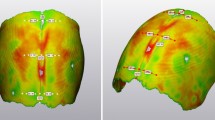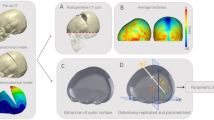Abstract
Purpose
The purpose of this study is to describe the technique and advantages and limitations of spring-assisted cranioplasty for sagittal suture synostosis.
Methods
Preliminary data are presented of the first 41 patients treated with this technique at our institution.
Results
The cephalic index was 75 after surgery and dropped to 74 one year after surgery. Mean blood loss of both procedures combined was 54 ml.
Conclusion
Spring-assisted cranioplasty requires only two small incisions and is at least as effective as other techniques with respect to the cephalic index. Blood loss, operative time, and complication rate are reduced. The most important disadvantage is the need to remove the springs in a second intervention. A second drawback is that the expansion of the spring is not controllable after placement. This can be partially intercepted by adjusting the spring (or the craniotomy) to the patient’s specific features.



Similar content being viewed by others
References
David L, Plikatis CM, Couture D et al (2010) Outcome analysis of our first 75 spring-assisted surgeries for scaphocephaly. J Craniofac Surg 21:3–9
Jimenez DF, Barone C, McGee ME et al (2004) Endoscopy-assisted wide vertex craniectomy, barrel stave osteotomies, and postoperative helmet molding therapy in the management of sagittal suture craniosynostosis. J Neurosurg Pediatr 100:407–417
Lauritzen C, Sugawara Y, Kocabalkan O et al (1998) Spring-mediated dynamic craniofacial reshaping. Scand J Plast Reconstr Hand Surg 32:331–338
Lauritzen CGK, Davis C, Ivarsson A et al (2008) The evolving role of springs in craniofacial surgery: the first 100 clinical cases. Plast Reconstr Surg 121:545–554
Mutchnick IS, Maugans TA (2012) Nonendoscopic, minimally invasive calvarial vault remodeling without postoperative helmeting for sagittal synostosis. J Neurosurg Pediatr 9:222–227
Pyle J, Glazier S, Couture D et al (2009) Spring-assisted surgery—a surgeon’s manual for the manufacture and utilization of springs in craniofacial surgery. J Craniofac Surg 20:1962–1968
Taylor JA, Maugans TA (2011) Comparison of spring-mediated cranioplasty to minimally invasive strip craniectomy and barrel staving for early treatment of sagittal craniosynostosis. J Craniofac Surg 22:1225–1229
Windh P, Davis C, Sanger C et al (2008) Spring-assisted cranioplasty vs Pi-plasty for sagittal synostosis—a long-term follow-up study. J Craniofac Surg 19:59–64
Conflict of interest
The authors declare that they have no conflict of interest.
Author information
Authors and Affiliations
Corresponding author
Additional information
This study was not subject to the Medical Research Involving Human Subjects Act (WMO) since this study does not involve any form of invasion of the study participant's integrity.
Rights and permissions
About this article
Cite this article
van Veelen, ML.C., Mathijssen, I.M.J. Spring-assisted correction of sagittal suture synostosis. Childs Nerv Syst 28, 1347–1351 (2012). https://doi.org/10.1007/s00381-012-1850-5
Received:
Accepted:
Published:
Issue Date:
DOI: https://doi.org/10.1007/s00381-012-1850-5




